Chapter Four: Synthesis

1. A Brief History of Sound Synthesis
Sound synthesis can be defined as the production of sound that originates electronically from scratch by either analog or digital circuitry, hence “synthetically,” as opposed to sound whose origins derive from recorded or sampled real-world sonic events. Oscillators, noise generators and the like originate the necessary electronic signal; filters, reverbs and enveloped amplifiers may modify it before the signal is sent to loudspeakers for acoustic propagation.
In the late 1940’s/early 1950’s separate European musical aesthetic movements developed around this distinction. The French championed musique concrète, whose ‘objet sonor’ or sonic object was to be derived from real-world acoustic events and their societal context (Pierre Schaeffer, Paris studios at Radio-diffusion-Telévision-Française or RTF, later became GRM). The Germans initially were most interested in a purely electronic signal flow from start to end which they called Elektronische Musik (Eimert and Stockhausen, Cologne studios at Nordwestdeuthcher Rundfunk or NWDR, later became WDR).
This distinction did not necessarily last long, with works such as Stockhausen’s 1955-6 Gesang der Jünglinge, or Varèse’s 1958 Poème Électronique combining both synthetic and real-world sound sources. The catch-all term of electroacoustic (or electro-acoustic), whose true meaning is still debated today, seemed to cover all music whose origin, reproduction and diffusion was not strictly acoustic from beginning to end. As well-known electronic composer Barry Schrader notes, this could also encompass the playing of a Mozart symphony from a record, tape or digital file, so we are still in search of a mutually-satisfactory term to describe what we do (or even when to hyphenate when we find it!).
Early Examples
First let me say that an amazingly-detailed catalog of early instruments, lovingly curated by Simon Crab, can be found at 120 Years of Electronic Music, with information and images far beyond the scope of this short page.
The history of circuits or instruments that created sounds synthetically can be traced back to the 19th Century. Elisha Gray (who lost the telephone patent to Alexander Graham Bell by hours) patented the Electro-harmonic telegraph in 1876, which in effect produced musically-pitched hums from oscillating circuits controlled by a piano-like keys (propagated acoustically through a vibrating washbasin, as amplification had not yet been invented). The ‘instrument’ eventually spanned two octaves of keys, and several public concerts were given.
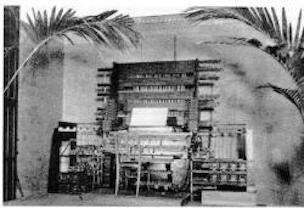
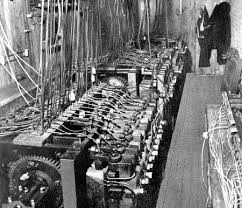


After meeting Termen, in 1928 Maurice Martenot developed what eventually became the Ondes-Martenot (pictured left), whose final form included a keyboard along with the original metal ring on a string which could be dragged along created glissandi. In fact, the whole keyboard was bounded by springs and floating on a resistive ribbon, so rocking one's fingers side to side really did create vibrato. Amplitude could be controlled by depressing a button with the free hand, making tremolo possible as well. Also of great interest were the many different speakers the instrument used, including a speaker driver attached to a gong, and a hollow lute-like speaker with sympathetically-vibrating strings across the top. The Ondes and the Theremin were used by many well-known composers of the time, including Messiaen, Strauss, Hindemith and Varèse. One signature piece for the Ondes was Messiaen's Turangalila-symphonie, calling for a skilled ‘ondist’ soloist, as they are called.
A few years later, Freidrich Trautwein developed the Trautonium, and notably, this electronic instrument too attempted to free its music from the equal-tempered piano keyboard by providing a stretched-wire interface one played upon. While position on the wire controlled pitch, pressure on the wire controlled amplitude. Unlike the previous instruments mentioned, its circuitry basis was subtractive synthesis, creating rich timbres, then shaping them through attenuation. Several updates ensued, including the Mixtur-Trautonium of 1936. Again, several well-known composers embraced the instrument, perhaps none more than Oskar Sala, who continued to compose for and perform on the instrument into the 21st Century.
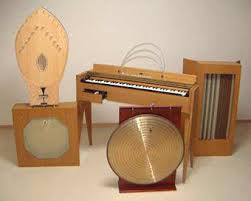
Synthesis in the Modern Era
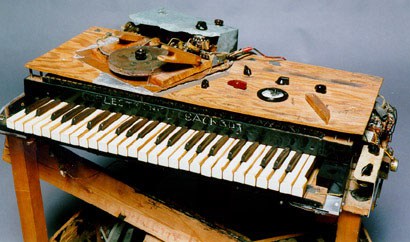
Rarely credited, the 1945 Electronic Sackbut (pictured on left) of Canadian physicist/composer Hugh LeCaine could be credited as the first voltage-controlled synthesizer, as three-axis pressure-driven control of amplitude, frequency and timbre (via real-time waveform modification) was accomplished by means of variable voltages. The instrument underwent significant changes and improvements through the years. A demonstration by the composer can be heard here.
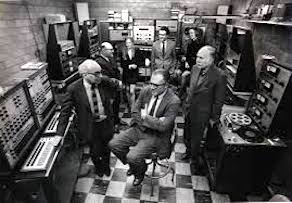
While most studios, including WDR and others primarily connected components to suit the compositional needs of the moment, the first major fully-integrated synthesizer of great significance is usually credited as the Columbia-Princeton RCA Mark II Electronic Music Synthesizer (affectionately called Victor), and was completed in 1955. At a cost of $250,000 from a Rockefeller grant (a fortune today), with almost 2,000 vacuum tubes, and 20 feet long, the RCA used a player-piano type punched paper roll (see right) to control the function of the various fixed modules—pitch, timbre, envelope, filter, etc., catering perfectly to the serial bent of its earliest users, such as Milton Babbitt, Mario Davidovsky, Halim El-Dabh, and later Charles Wuorinen. Also of note are the several women pioneers who used the instrument, including Pril Smiley and Alice Shields (several pictured left). RCA's commercial interest was in supporting a machine that they hoped could someday automatically generate chart-topping pop tunes in the style of the greatest hits of the day. Still waiting…but as of the time of this writing, EDM is cresting using its successor technology. Pictures courtesy of Columbia University.
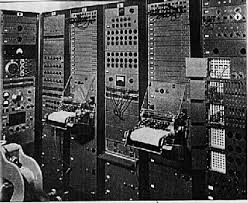
In the mid-1960’s, Robert Moog (who had designed the envelope generators for the RCA Mark II as well as solid-state Theremins mentioned above) released a series of self-contained modular instruments that made voltage-controlled synthesis affordable to many university studios and private individuals. Signals were routed via patch cords. His instruments were popularized by Wendy Carlos's Switch-on Bach album, which featured a picture of the current instrument in 1968. A more fixed-signal-path instrument, the Mini-Moog was released shortly thereafter. The ARP 2600 modular, similar in design, also appeared in the 1970's along with the Serge and many more. During the 1960's, London-based EMS released a VCS3 (known as the Putney) and later the legendary Synthi 100.
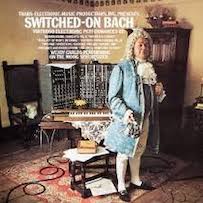
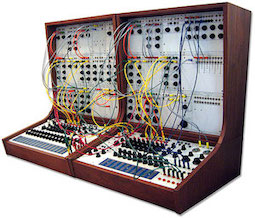
Also in the early 1960's, with a $200,000 grant, Donald Buchla, working closely with Morton Subotnik and the San Francisco Tape Music Center created his own modular entry, featuring “stage sequencers” to produce the ostinati the composer would improvise over with such album-length works as The Wild Bull and Silver Apples of the Moon. The Buchla Model 100 is pictured on the left. Buchla synths were also used by Terry Riley, Pauline Oliveros and Steve Reich. Along with Buchla and Moog, a slew of small, affordable keyboard instruments followed, with polyphony being introduced, such as the Oberheim 4-voice FVS-1 in the mid-1970's and their keyboard-less polyphonic SEM ("synthesizer expander module") box.
Beginning in the mid-70’s, hybrid instruments, such as our own studio's E-mu modular, which had digital-to-voltage capabilities to store voltage sequences that could be applied to pitches, filters or any cv input, became popular. Precursors included the Bell Labs' GROOVE (Generated Realtime Operations On Voltage-controlled Equipment) system, pioneered by Max Mathews, composer Laurie Spiegel and others, that hooked a bulky Honeywell DDP224 mainframe up to an analog synthesizer, digitally recording and playing back performed notes and knob-turning. This was followed by a more modest mid-70's Oberheim DS-2(A) digital-to-analog sequencer used by Jan Hammer and others to record up to 48 voltage events (could be notes or not) from a synthesizer, which could then be divided between three separate voltage streams and recorded one event at a time. The box could then vary the playback speed when reproducing and be patched to a variety of a synthesizer's control inputs to vary pitch, timbre and amplitude. These hybrid innovations were quickly followed by real-time all-digital instruments such as the Synclavier picture on the right (a commercial outgrowth of the Dartmouth Digital Synthesizer) and Fairlight CMI, and just a bit later by the category-killing (because of its affordability) Yamaha DX7, based on the FM research of Stanford composer John Chowning.
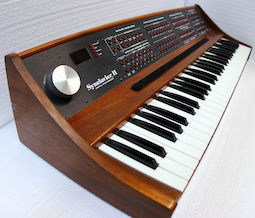
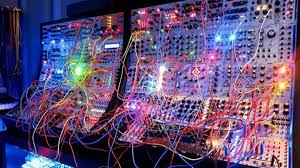
As all things (with perhaps the exception of the punch cards I began my digital synthesis life using) eventually return, the allure of totally configurable, patchable analog and hybrid modular synthesizers has now returned with the Eurorack systems, and dozens of companies and inventors creating all sorts of wild modules we never had back in the day-and lots and lots of flashing LEDs. Visit synthtopia.com, vcvrack.com, or modulargrid.net to get a sense of what is available. In addition, Hollywood scores and TV shows are again replete with all-analog-synthesized scored created on new or vintage modular systems.